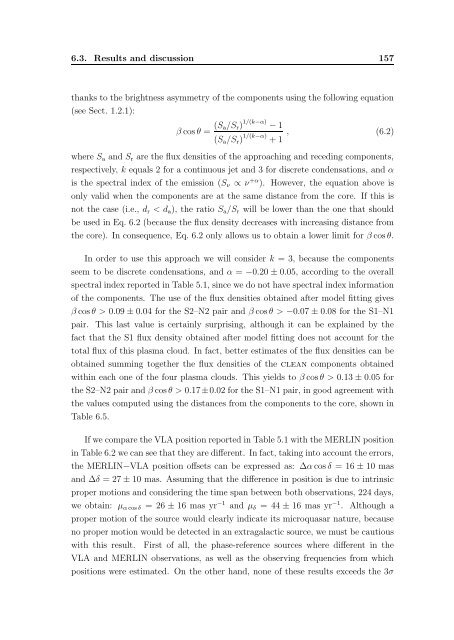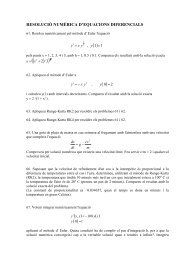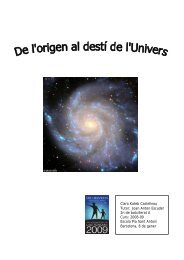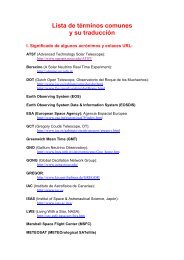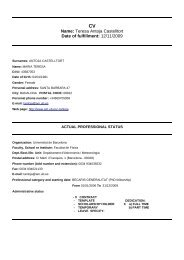Universitat de - Departament d'Astronomia i Meteorologia ...
Universitat de - Departament d'Astronomia i Meteorologia ...
Universitat de - Departament d'Astronomia i Meteorologia ...
Create successful ePaper yourself
Turn your PDF publications into a flip-book with our unique Google optimized e-Paper software.
6.3. Results and discussion 157<br />
thanks to the brightness asymmetry of the components using the following equation<br />
(see Sect. 1.2.1):<br />
β cos θ = (Sa/Sr) 1/(k−α) − 1<br />
(Sa/Sr) 1/(k−α) + 1<br />
, (6.2)<br />
where Sa and Sr are the flux <strong>de</strong>nsities of the approaching and receding components,<br />
respectively, k equals 2 for a continuous jet and 3 for discrete con<strong>de</strong>nsations, and α<br />
is the spectral in<strong>de</strong>x of the emission (Sν ∝ ν +α ). However, the equation above is<br />
only valid when the components are at the same distance from the core. If this is<br />
not the case (i.e., dr < da), the ratio Sa/Sr will be lower than the one that should<br />
be used in Eq. 6.2 (because the flux <strong>de</strong>nsity <strong>de</strong>creases with increasing distance from<br />
the core). In consequence, Eq. 6.2 only allows us to obtain a lower limit for β cos θ.<br />
In or<strong>de</strong>r to use this approach we will consi<strong>de</strong>r k = 3, because the components<br />
seem to be discrete con<strong>de</strong>nsations, and α = −0.20 ± 0.05, according to the overall<br />
spectral in<strong>de</strong>x reported in Table 5.1, since we do not have spectral in<strong>de</strong>x information<br />
of the components. The use of the flux <strong>de</strong>nsities obtained after mo<strong>de</strong>l fitting gives<br />
β cos θ > 0.09 ± 0.04 for the S2–N2 pair and β cos θ > −0.07 ± 0.08 for the S1–N1<br />
pair. This last value is certainly surprising, although it can be explained by the<br />
fact that the S1 flux <strong>de</strong>nsity obtained after mo<strong>de</strong>l fitting does not account for the<br />
total flux of this plasma cloud. In fact, better estimates of the flux <strong>de</strong>nsities can be<br />
obtained summing together the flux <strong>de</strong>nsities of the clean components obtained<br />
within each one of the four plasma clouds. This yields to β cos θ > 0.13 ± 0.05 for<br />
the S2–N2 pair and β cos θ > 0.17±0.02 for the S1–N1 pair, in good agreement with<br />
the values computed using the distances from the components to the core, shown in<br />
Table 6.5.<br />
If we compare the VLA position reported in Table 5.1 with the MERLIN position<br />
in Table 6.2 we can see that they are different. In fact, taking into account the errors,<br />
the MERLIN−VLA position offsets can be expressed as: ∆α cos δ = 16 ± 10 mas<br />
and ∆δ = 27 ± 10 mas. Assuming that the difference in position is due to intrinsic<br />
proper motions and consi<strong>de</strong>ring the time span between both observations, 224 days,<br />
we obtain: µα cos δ = 26 ± 16 mas yr −1 and µδ = 44 ± 16 mas yr −1 . Although a<br />
proper motion of the source would clearly indicate its microquasar nature, because<br />
no proper motion would be <strong>de</strong>tected in an extragalactic source, we must be cautious<br />
with this result. First of all, the phase-reference sources where different in the<br />
VLA and MERLIN observations, as well as the observing frequencies from which<br />
positions were estimated. On the other hand, none of these results exceeds the 3σ


